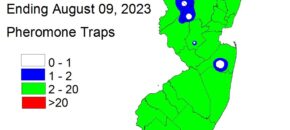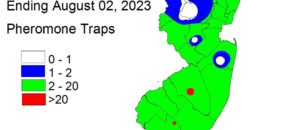Corn earworm (CEW) activity has increased significantly as of this Tuesday (8/9/23). While some trap numbers (blacklight and pheromone) in the northern counties are not excessively high, there have been much higher counts almost everywhere, with a number of very high trap catches. The number of pheromone traps reporting since the beginning of the week […]
Continue reading...Vegetable IPM Update 8/09/23

Sweet Corn Fall armyworm (FAW) infestations in whorl stage plantings are increasingly reaching threshold levels, and although they are not found in every field, FAW damage is in all corn growing areas at this time. In scouted fields, some infestations in whorl corn are in excess of 20%, and are likely much higher in the […]
Continue reading...Hackettstown Livestock Auction Results for July 25, 2023

This auction sells: lambs, sheep, goats, calves, beef cattle, pigs, rabbits, and all types of heavy fowl. Auctions are held every Tuesday with the first sale beginning at 10:00 am and ending with the last sale at 5:30 pm. Hay, straw, grain, and firewood are also for sale. Hackettstown Livestock Auction Farm Fresh Eggs available […]
Continue reading...Bilingual Labeling: Parts of Pesticide Labels Will be Required to Also Be In Spanish
EPA Seeks Public Comments to Ensure Information on Bilingual (Spanish) Pesticide Labels Reaches the Hands of America’s Farmworkers [Posted to EPA OPP Update August 3, 2023]. The U.S. Environmental Protection Agency (EPA) is seeking public comments on h… Read More »
Continue reading...Vegetable IPM Update 8/02/23

Sweet Corn Occurrences of Fall armyworm (FAW) injury are becoming more common, with infestations discovered as far north as Warren County this week. Some infestations in whorl corn are in excess of 20%. It is likely that economic infestations are present in much of southern New Jersey now, and could occur anywhere. Growers are advised […]
Continue reading...Rutgers Tree Fruit IPM Report for August 02, 2023
Peach: Oriental Fruit Moth: A biofix point for OFM was set on 4/10 in both northern and southern counties. All timings for first generation OFM have past. Third generation timings are updated below: OFM 2nd Generation Timing Insecticide Type County/Region Degree Days by 7/25 base 45 Conventional 2100-2200 2350-2450 Diamide 2025-2150 2375-2450 Gloucester – Southern […]
Continue reading...